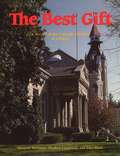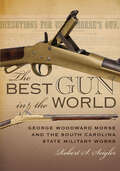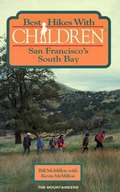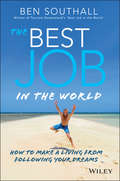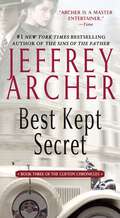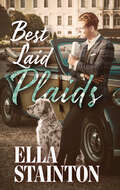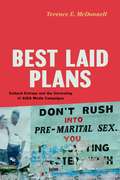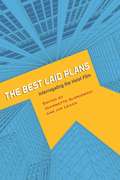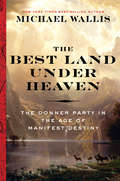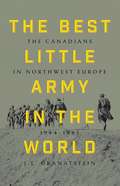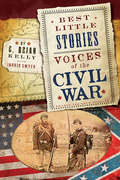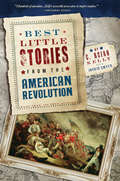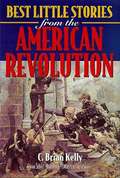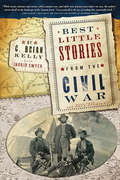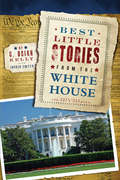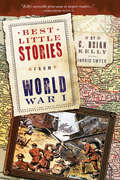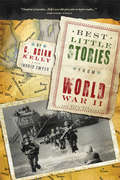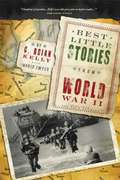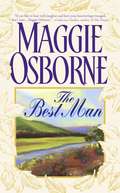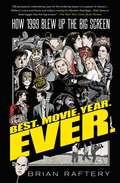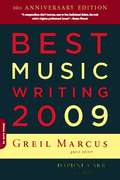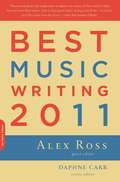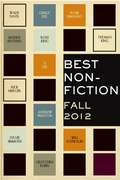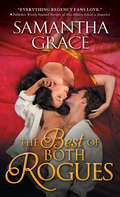- Table View
- List View
The Best Gift: A Record of the Carnegie Libraries in Ontario
by Margaret Beckman Stephen Langmead John BlackThis book is a vivid reminder of the early days of library development in Ontario. The beautiful buildings which still grace Ontario towns and villages, as illustrated, are a part of our provincial heritage. By the turn of the century, a public library was perceived as an important element in the civic fabric of almost every Ontario community. However, the introduction of the Carnegie grants for library buildings gave impetus to the Ontario government programme for library development, and provided a focus for increased support of library services. Rivalry among neighbouring communities to secure a Carngie library heightened this awareness, as did the publicity – in some instances even controversy – which surrounded each step of the grant seeking, site selection and plan approval process. As well, the hitherto unexplored story of Carnegie grant process in each community has been examined, and the role of one man, James Bertram, secretary to Andrew Carnegie, is revealed in absorbing detail. Library plans and design elements are also discussed, and the influence of a few architects on the building designs is revealed; the fascinating involvement of Frank Lloyd Wright in the Pembroke Carnegie library building is one such example.
The Best Gun in the World: George Woodward Morse and the South Carolina State Military Works
by Robert S. SeiglerA thoroughly researched account of weapons innovation and industrialization in South Carolina during the Civil War and the man who made it happen.A year after seceding from the Union, South Carolina and the Confederate States government faced the daunting challenge of equipping soldiers with weapons, ammunition, and other military implements during the American Civil War. In The Best Gun in the World, Robert S. Seigler explains how South Carolina created its own armory and then enlisted the help of a weapons technology inventor to meet the demand. Seigler mined state and federal factory records, national and state archives, and US patents for detailed information on weapons production, the salaries and status of free and enslaved employees, and other financial records to reveal an interesting, distinctive story of technological innovation and industrialization in South Carolina.George Woodward Morse, originally from New Hampshire, was a machinist and firearms innovator, who settled in Louisiana in the 1840s. He invented a reliable breechloading firearm in the mid-1850s to replace muzzleloaders that were ubiquitous throughout the world. Essential to the successful operation of any breechloader was its ammunition, and Morse perfected the first metallic, center-fire, pre-primed cartridge, his most notable contribution to the development of modern firearms.The US War Department tested Morse rifles and cartridges prior to the beginning of the Civil War and contracted with the inventor to produce the weapons at Harpers Ferry Armory. However, when the war began, Morse, a slave-holding plantation owner, determined that he could sell more of his guns in the South. The South Carolina State Military Works originally designed to cast cannon, produced Morse’s carbine and modified muskets, brass cartridges, cartridge boxes, and other military accoutrements. The armory ultimately produced only about 1,350 Morse firearms. For the next twenty years, Morse sought to regain his legacy as the inventor of the center-fire brass cartridges that are today standard ammunition for military and sporting firearms.“Does justice to one of the greatest stories in American firearms history. If George Woodward Morse had not sided with the Confederacy, his name might be as famous today as Colt or Winchester.” —Gordon L. Jones, Atlanta History Center “Excellent and well-researched.” —Patrick McCawley, South Carolina Department of Archives and History“For connoisseurs and scholars of military history (especially Civil War), history of technology, or Southern/South Carolina history, this is a must-read and reference volume pertaining to a previously little-known aspect of the nineteenth century that had a far-reaching impact in the manner wars would be fought by soldiers decades later.” —Barry L. Stiefel, College of Charleston
Best Hikes with Children in San Francisco's South Bay
by Bill Mcmillon Kevin McmillonGuides to day hikes and overnighters for families. Tips on hiking with kids, safety, and fostering a wilderness ethic.
The Best Job in the World
by Ben SouthallThe true story of the man with the Best Job in the WorldThe Best Job in the World is the story of how following your passions can lead to life-changing opportunities. Adventurer Ben Southall shares his experiences and lessons learned as the winner of the inaugural Tourism Queensland's Best Job in the World campaign, and reveals how this has led to ongoing opportunities since. Part autobiography, part insight into the power of a unique marketing campaign, this book follows Ben's journey--from leaving the UK on his own expedition around Africa to his new role as caretaker of Hamilton Island on the Great Barrier Reef. You'll learn about the skills and experiences that shaped Ben's path, together with the inevitable pitfalls that he faced along the way to living his dream.The sole winner of the Best Job in the World campaign, Ben's perspective is a unique one to share the serious challenges that arose from being catapulted into a high profile job in an idyllic location. Humorous and poignant, the story is as much holistic life guide as travel guide, providing a motivational and inspirational tale that may just be the push you need to:Get inspired--see the opportunities around you and grab them with both handsEmbrace the unknown, overcome life's obstacles and challenge expectationsLive out your dreams and be your authentic selfClimb out of the rut and take part in the world around youIn The Best Job in the World, Ben Southall answers the questions everyone is asking: "What is it like? Is it really the best job in the world?" You'll learn how to transform your interests and passions into a flexible, long-term career, and how following the road less travelled can lead to living your best life. If you're dissatisfied, stuck in a rut or merely curious, The Best Job in the World is a must-read tale of aspiration, inspiration and motivation.
Best Kept Secret (The Clifton Chronicles #3)
by Jeffrey ArcherJeffrey Archer's mesmerizing saga of the Clifton and Barrington families continues...1945, London. The vote in the House of Lords as to who should inherit the Barrington family fortune has ended in a tie. The Lord Chancellor's deciding vote will cast a long shadow on the lives of Harry Clifton and Giles Barrington. Harry returns to America to promote his latest novel, while his beloved Emma goes in search of the little girl who was found abandoned in her father's office on the night he was killed. When the general election is called, Giles Barrington has to defend his seat in the House of Commons and is horrified to discover who the Conservatives select to stand against him. But it is Sebastian Clifton, Harry and Emma's son, who ultimately influences his uncle's fate.In 1957, Sebastian wins a scholarship to Cambridge, and a new generation of the Clifton family marches onto the page. But after Sebastian is expelled from school, he unwittingly becomes caught up in an international art fraud involving a Rodin statue that is worth far more than the sum it raises at auction. Does he become a millionaire? Does he go to Cambridge? Is his life in danger? Best Kept Secret, the third volume in Jeffrey Archer's bestselling series, will answer all these questions but, once again, pose so many more.
Best Laid Plaids: A Paranormal Historical Romance (Kilty Pleasures #1)
by Ella StaintonIn 1920s Scotland, even ghosts wear plaid.Welcome to a sexy, spooky new paranormal historical series from debut author Ella Stainton.Scotland, 1928Dr. Ainsley Graham is cultivating a reputation as an eccentric.Two years ago, he catastrophically ended his academic career by publicly claiming to talk to ghosts. When Joachim Cockburn, a WWI veteran studying the power of delusional thinking, arrives at his door, Ainsley quickly catalogues him as yet another tiresome Englishman determined to mock his life’s work.But Joachim is tenacious and openhearted, and Ainsley’s intrigued despite himself. He agrees to motor his handsome new friend around to Scotland’s most unmistakable hauntings. If he can convince Joachim, Ainsley might be able to win back his good name and then some. He knows he’s not crazy—he just needs someone else to know it, too.Joachim is one thesis away from realizing his dream of becoming a psychology professor, and he’s not going to let anyone stop him, not even an enchanting ginger with a penchant for tartan and lewd jokes. But as the two travel across Scotland’s lovely—and definitely, definitely haunted—landscape, Joachim’s resolve starts to melt. And he’s beginning to think that an empty teaching post without the charming Dr. Graham would make a very poor consolation prize indeed…
Best Laid Plans: Cultural Entropy and the Unraveling of AIDS Media Campaigns
by Terence E. McdonnellWe see it all the time: organizations strive to persuade the public to change beliefs or behavior through expensive, expansive media campaigns. Designers painstakingly craft clear, resonant, and culturally sensitive messaging that will motivate people to buy a product, support a cause, vote for a candidate, or take active steps to improve their health. But once these campaigns leave the controlled environments of focus groups, advertising agencies, and stakeholder meetings to circulate, the public interprets and distorts the campaigns in ways their designers never intended or dreamed. In Best Laid Plans, Terence E. McDonnell explains why these attempts at mass persuasion often fail so badly. McDonnell argues that these well-designed campaigns are undergoing "cultural entropy": the process through which the intended meanings and uses of cultural objects fracture into alternative meanings, new practices, failed interactions, and blatant disregard. Using AIDS media campaigns in Accra, Ghana, as its central case study, the book walks readers through best-practice, evidence-based media campaigns that fall totally flat. Female condoms are turned into bracelets, AIDS posters become home decorations, red ribbons fade into pink under the sun--to name a few failures. These damaging cultural misfires are not random. Rather, McDonnell makes the case that these disruptions are patterned, widespread, and inevitable--indicative of a broader process of cultural entropy.
The Best Laid Plans: Interrogating the Heist Film
by Jeannette Sloniowski Jim LeachThe heist—a carefully organized robbery of a financial institution or other lucrative business—has been a persistent and popular mainstay of the crime film. The Best Laid Plans: Interrogating the Heist Film asks the question: why has the heist film proved so appealing to audiences over many years and in diverse cultural contexts? The twelve essays in this volume, edited by Jim Leach and Jeannette Sloniowski, will explore the significance of the heist film in different national cinemas, as well as its aesthetic principles and ideological issues such as representation of gender, race, and class. The essays are organized in three parts dealing with the heist film's international presence, the subgenre's social and cultural implications, and some theoretical ways of approaching it. For example, contributor Tim Palmer challenges traditional notions of French film history that emphasize critically acclaimed art films by pointing to the rich achievements of critically defamed and neglected, but extremely popular, crime films; Gaylyn Studlar surveys heist films in light of feminist theories that illuminate stereotypical characterizations of both men and women in the heist; and Hamilton Carroll compares James Marsh’s documentary Man on a Wire—which draws on heist conventions to depict Philippe Petit’s unauthorized tightrope walk in 1974 between the two towers of the World Trade Center—to Spike Lee’s New York–set heist film Inside Man. The Best Laid Plans includes an accessible group of essays that will meet the needs of students and scholars in film and media studies by offering new insights into an important and neglected area in genre criticism.
The Best Land Under Heaven: The Donner Party In The Age Of Manifest Destiny
by Michael Wallis“A book so gripping it can scarcely be put down. . . . Superb.”— New York Times Book Review "WESTWARD HO! FOR OREGON AND CALIFORNIA!" In the eerily warm spring of 1846, George Donner placed this advertisement in a local newspaper as he and a restless caravan prepared for what they hoped would be the most rewarding journey of a lifetime. But in eagerly pursuing what would a century later become known as the "American dream," this optimistic-yet-motley crew of emigrants was met with a chilling nightmare; in the following months, their jingoistic excitement would be replaced by desperate cries for help that would fall silent in the deadly snow-covered mountains of the Sierra Nevada. We know these early pioneers as the Donner Party, a name that has elicited horror since the late 1840s. With The Best Land Under Heaven, Wallis has penned what critics agree is “destined to become the standard account” (Washington Post) of the notorious saga. Cutting through 160 years of myth-making, the “expert storyteller” (True West) compellingly recounts how the unlikely band of early pioneers met their fate. Interweaving information from hundreds of newly uncovered documents, Wallis illuminates how a combination of greed and recklessness led to one of America’s most calamitous and sensationalized catastrophes. The result is a “fascinating, horrifying, and inspiring” (Oklahoman) examination of the darkest side of Manifest Destiny.
The Best Lawyer In A One-Lawyer Town
by Dale BumpersAutobiography of the former Arkansas governor and legislator.
The Best Little Army In The World
by J. L. GranatsteinThis is the story of the Canadian First Army that fought its way from Juno Beach at D-Day in June, 1944, through Normandy, into the Netherlands to liberate that country, to the terrible battles in the Scheldt area, and finally into Germany in 1945. This is also the story of how Canada, which had no army to speak of in 1939, raised a citizen army and turned it into one of the very best fighting armies in World War II, one which helped defeat the most implacable, desperate and battle-hardened German army over the course of 11 months in ’44 and ’45. Canada has always produced astonishingly effective soldiers, and this book is about one of their finest moments.The argument of this book is that the Canadian army changed from an amateur force in 1939–41 into the supremely skilled and formidably equipped army by late 1944 that was able to prevail against a first-class enemy. In effect, the citizen soldiers became professionals, able to organize and plan, to move and fight, and to win against the best army the world had ever seen, the Wehrmacht.This is the astonishing story of how Canada mobilized its men, women and industrial resources to raise a military of 1.1 million from a population of only 11 million. The army trained and learned on the job, and though the losses in killed and wounded were high, they were less than in the Great War. This is a story of courage, skill and persistence.
Best Little Stories: Voices of the Civil War
by C. Brian Kelly Ingrid SmyerThe Civil War You Never Knew...Behind the conflict that divided a nation and forever changed its citizens are the riveting tales of the men and women who made an impact in the Civil War, both on and off the battlefield. Drawn from the writings of soldiers, slaves, politicians, and military leaders, Best Little Stories: Voices of the Civil War extends beyond the statistics and battle accounts to present the intensely personal, human side of the conflict. Fascinating characters come to life, including:James Alexander Walker, who served with honor under Stonewall Jackson, even after he was booted from the Virginia Military Institute for talking back to the notoriously stodgy Professor Jackson.Charles Strahan, a Confederate veteran who made strides to reconcile the Blue and Gray when he raised money to erect a monument to honor his former enemy, the soldiers of the Union army.Gen. Julius H. Stahel, winner of the Medal of Honor, who was egregiously omitted from the official after-action report on the battle of Piedmont, Virginia, despite having led the Union forces to victory after suffering from a gunshot wound.
Best Little Stories from the American Revolution: More Than 100 True Stories (2nd edition)
by C. Brian Kelly150 true stories from those who lived it bring to life the triumph and tragedy of the American Revolution. Prize-winning journalist C. Brian Kelly has collected the most riveting letters, diaries, and autobiographies from the people who lived during the Revolutionary War, weaving in pertinent historical background to create this compelling collection of stories. Readers will discover the history of the war as it affected soldiers, leaders, and common folk, going beyond the usual recounting of strategic battles. Here in vivid detail are the experiences of the people who lived the war and the dreams and aspirations that prodded them to pursue liberty at all costs.
Best Little Stories from the American Revolution: More Than 100 True Stories
by Ingrid Smyer-Kelly C. Brian Kelly"Best Little Stories from the American Revolution", by C. Brian Kelly, is a journalistic history of the birth of the United States in the form of more than 100 vignettes reflecting the period and describing how the colonies courageously prevailed against vastly superior forces.
Best Little Stories from the Civil War: More Than 100 True Stories
by C. Brian KellyBehind the bloody battles, strategic marches, and decorated generals lie more than 100 intensely personal, true stories you haven't heard before. In Best Little Stories from the Civil War, soldiers describe their first experiences in battle, women observe the advances and retreats of armies, spies recount their methods, and leaders reveal the reasoning behind many of their public actions.
Best Little Stories from the White House
by C. Brian KellyBehind the White House's impressive facade lies the long history of the men who have lived and governed within it's walls. From births to deaths, weddings to funerals, the White House has seen it all. In Best Little Stories from the White House, author C. Brian Kelly takes us on a tour of the White House's fascinating history, giving us a glimpse of the most memorable presidential moments: Theodore Roosevelt 's children once snuck their pony upstairs in the White House elevator to cheer up their sick brother. Winston Churchill once suffered a minor heart episode while struggling with a stuck window in the White House. John Quincy Adams was known to skinny-dip in the Potomac. Woodrow Wilson liked to chase up and down the White House corridors playing "rooster fighting" with his daughter Nellie.
Best Little Stories from World War I
by C. Brian Kelly Ingrid SmyerBehind the tangled alliances, feuding royals, and deadly battles are the nearly 100 riveting true stories of the men and women who lived, fought, and survived the first Great War. Based on the writings of soldiers, politicians, kings, nurses, and military leaders, Best Little Stories from World War I humanizes their foibles, triumphs, and tragedies--and chronicles how the emergence of fervent national pride led not only to ruthless combat, but a critical turning point in the twentieth century.Fascinating characters come to life, including:Lady Almina, the 5th Countess of Carnavon, who turned her husband's Highclere Castle into a luxurious military hospital for British officers (and inspired the hit television show Downton Abbey). Otto Roosen, the high-flying German reconnaissance pilot, who was shot down not only one but twice--first by the Canadian ace Billy Bishop and then by a fellow German--and survived.Arthur Guy Empey, the American who volunteered for the British Army after the sinking of the Lusitania, then wrote a bestselling memoir about life in the muddy trenches of the western front.
Best Little Stories from World War II
by C. Brian KellyBEHIND THE GREAT POWERS , global military conflict, and infamous battles are more than 100 incredible stories that bring to life the Second World War. During the six years of war were countless little-known moments of profound triumph and tragedy, bravery and cowardice, and good and evil. These amazing and unbelievable stories of brotherhood, redemption, escape, and civilian courage shed new light on the war that gripped the entire world. Experience the action through the eyes of people like: Lieutenant Jacob Beser, who was aboard both the Enola Gay and Bock's Car and felt the force of the shockwave that nearly destroyed the planes after dropping the H-bombs that obliterated Hiroshima and Nagasaki. Professor William Miller, who collapsed during a death march of POWs in Germany and was saved by the same man who had rescued him from what would have been a fatal car wreck in Pennsylvania five years earlier. The brave civilians who answered the British Admiralty's call to help rescue an army from Dunkirk during the height of a dangerous battle and sailed small fishing boats into relentless German fire, ultimately saving 335,000 men from
Best Little Stories from World War II: More Than 100 True Stories
by C. Brian Kelly Ingrid SmyerBest Little Stories of World War II is a journalistic history of World War II in the form of more than 150 vignettes reflecting the war\'s humor and pathos, triumph and tragedy. Here is the story of the war as it affected soldiers and civilians, leaders and common folk alike real people who bravely endured the times. While one can never learn or tell all their stories, one can honor their memories by recounting their amazing, inspiring, poignant, ironic, and yes, even pitiful stories in this war to end all wars. Included are such stories as: Professor William Miller, who collapsed during a 75-mile "death march" in Germany and was saved b the same man who had rescued him from a car wreck in Pennsylvania five years earlier. Karl Fuchs, a German tank gunner who wrote tender letters to his wife as his Panzer division invaded Russia. Jim Kilroy, worker at a shipyard in Quincy, Massachusetts, whose say of signing off on his inspections became the morale-boosting slogan for countless GI\'s: "Kilroy was here. " Kasuo Sakamaki, pilot of a midget submarine who was captured after a failed attempt to infiltrate Pearl Harbor. "Kitty," the diary of a Jewish teenager in Amsterdam rescued after the war by her father and published in thirty-two languages as Anne Frank: Diary of a Young Girl. These and many more stories and anecdotes fill the pages of this fascinating book that will make World War II come alive with the thoughts and feelings of those who were there.
The Best Man
by Maggie OsborneThis is one of the best books that I have read in a long time. It made me laugh, cry, and the way love won out in the end was wonderful. -- Beverly Willeford, Bev's Books (Highlands, TX) Joe Roark's three daughters have just learned that the only way they will inherit their father's ranch is to drive a herd of 1,200 longhorns to Dodge City, Kansas and sell them there. If they fail, his wife Lola inherits everything. Terrified, but knowing they will be penniless without their inheritance, the girls decide to drive the cattle. What follows is an unparalleled adventure filled with the raw wildness of nature, the force of sheer determination, and an unexpected love that will change one sister's life. . .
Best. Movie. Year. Ever.: How 1999 Blew Up the Big Screen
by Brian RafteryFrom a veteran culture writer and modern movie expert, a celebration and analysis of the movies of 1999—arguably the most groundbreaking year in American cinematic history.In 1999, Hollywood as we know it exploded: Fight Club. The Matrix. Office Space. Election. The Blair Witch Project. The Sixth Sense. Being John Malkovich. Star Wars: The Phantom Menace. American Beauty. The Virgin Suicides. Boys Don’t Cry. The Best Man. Three Kings. Magnolia. Those are just some of the landmark titles released in a dizzying movie year, one in which a group of daring filmmakers and performers pushed cinema to new limits—and took audiences along for the ride. Freed from the restraints of budget, technology (or even taste), they produced a slew of classics that took on every topic imaginable, from sex to violence to the end of the world. The result was a highly unruly, deeply influential set of films that would not only change filmmaking, but also give us our first glimpse of the coming twenty-first century. It was a watershed moment that also produced The Sopranos; Apple’s Airport; Wi-Fi; and Netflix’s unlimited DVD rentals. Best. Movie. Year. Ever. is the story of not just how these movies were made, but how they re-made our own vision of the world. It features more than 130 new and exclusive interviews with such directors and actors as Reese Witherspoon, Edward Norton, Steven Soderbergh, Sofia Coppola, David Fincher, Nia Long, Matthew Broderick, Taye Diggs, M. Night Shyamalan, David O. Russell, James Van Der Beek, Kirsten Dunst, the Blair Witch kids, the Office Space dudes, the guy who played Jar-Jar Binks, and dozens more. It’s the definitive account of a culture-conquering movie year none of us saw coming…and that we may never see again.
Best Music Writing 2009
by Greil MarcusLegendary critic Greil Marcus takes the helm for the landmark tenth edition of Da CapoOCOs annual compendium of the best in music writing"
Best Music Writing 2011
by Alex Ross Daphne CarrTwelfth in the acclaimed series of annual collections celebrating the best writing on every style of music, from rock to hip-hop, R&B to jazz, pop to blues, and more
Best Non-Fiction Fall 2012 Sampler
by Random HouseFrom Random House of Canada Limited, a must-read collection of this fall’s best non-fiction. It is our richest season yet, and we’re thrilled to offer you a taste of our smartest, most persuasive, and thoughtful non-fiction titles. Step back in time and experience the world through the lenses of some of history’s most influential and adventuring figures—da Vinci, George Mallory, van Gogh; get to know, in unmatched detail, three of Canada’s most intriguing personalities: a beloved hockey coach, a timeless performer, and one of our most entertaining satirists; share in poignant moments of family, love, and loss in unforgettable memoirs; and, engage in some of the most topical debates of today, from religion’s role in foreign policy to work-life balance to the Native American experience. Showcasing only the best in non-fiction from Rick Mercer, award–winners Ross King and Wade Davis, Rosie DiManno, Andrew Preston, Sylvie Simmons, Modris Eksteins, Thomas King, and Gretchen Rubin, as well as introducing stories and ideas from bright talents like Will Schwalbe, Gerry Dee, and JJ Lee, Best of Non-Fiction Fall 2012 will capture your imagination and spark your curiosity, bringing you to some of this season’s most gripping, reflective, and stirring reads.
The Best of Both Rogues
by Samantha Grace"Everything Regency fans love."-Publishers Weekly Starred Review of Miss Hillary Schools a ScoundrelThe worst thing Mr. Benjamin Hillary ever did was leave his bride-to-be on their wedding day. The hardest thing he will ever have to do is watch her marry another man.After two long years abroad, Ben finds Eve every bit as captivating as she was the first time he saw her, and he vows to set things right. Lady Eve Thorne has a new man in her life, and Ben is nothing but trouble. She is no longer a starry-eyed young woman, and now that he's back, he can go hang for all she cares. At least that's what she keeps telling herself... Rival Rogues series: One Rogue Too Many, In Bed with a Rogue, The Best of Both Rogues
